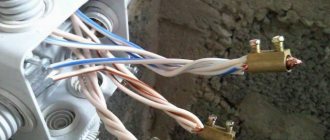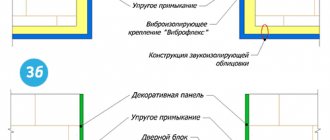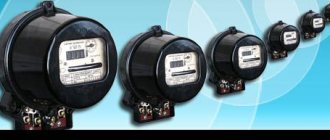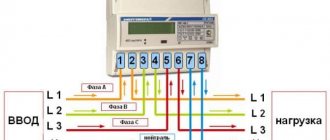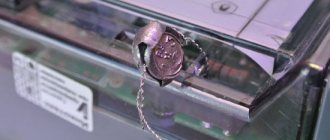Housing and communal services
Mikhail Bondarev Author of the article
14
There are a number of reasons why an electric energy meter may need to be replaced, and it is important to know how to do it correctly. In some houses where meters were installed more than 16 years ago, planned replacement is taking place due to their technical obsolescence.
Among other reasons:
- failure;
- service life has expired;
- replacement with a modern multi-tariff meter for significant savings in resource consumption.
The procedure for replacing metering devices is subject to rules that should be strictly followed. Let's list the regulatory documents and clarify who should and at whose expense the replacement is made.
Types of electricity metering devices
The operation of any meter consists in the interaction of several elements: input and output contacts, internal circuit.
The principle of operation of any meter consists in the interaction of several elements: input and output contacts, internal circuit (mechanical, electronic). Depending on the network used, devices that switch with AC or DC circuits are distinguished. The former are more widespread and are divided into the following types:
- induction (used for over 150 years);
- electronic (modern metering devices);
- hybrid (combine the functions of the previous two types).
New connections are made using electronic devices. Experts also recommend replacing old induction options with more modern devices.
General requirements for meters
Any of the specified types of electrical metering devices must meet several mandatory requirements:
- compliance with the register - a list of imported and domestic brands of manufacturers that have passed certification, certification and are approved for installation on the territory of the Russian Federation;
- registration after putting into operation a new device or upgrading an old one (any changes, internal or external, are considered), it is important to check the correspondence of the device readings and the data recorded in the report;
- installation height – no more than 1.7 meters from the floor level;
- the corresponding service life of the electricity meter in the apartment.
If the device does not pass the test on at least one of the points, its readings are not taken into account. Penalties may be imposed. This is especially true for large industrial facilities with significant levels of light consumption.
Which meter is better to install?
What is better, install a single-phase or three-phase meter? The question is actually serious. But it can be answered this way. If you are the owner of a small cottage or summer house, then the single-phase option will be just right. If your country house is a multi-storey building with swimming pools, saunas and other pleasant fruits of civilization, then it is better to install a three-phase electricity metering and control device. The most important thing here is to connect the device correctly and evenly distribute the load on each circuit of the three-phase network.
Replacement standards
Outdated models or those that have been used for a long time are not subject to replacement, repair or state verification. Replacement is carried out during a period called the inspection interval. The permissible period is 16 years from the date of the last inspection. Another situation is an obvious breakdown of an electrical device. In this case, replacement is made immediately. Documents on the basis of which the process takes place:
- Decree of the Government of the Russian Federation No. 442 dated May 4, 2012 - determines the level of accuracy of instruments, the required indicator is 2.0 and higher;
- The decision of Gosstandart and the letter from Gosenergonadzor dated 2000 dictate the procedure for replacing technical metering devices.
If the residential premises are in the possession of the consumer, replacement of devices at the end of the service life of the electric meter is carried out at his expense.
However, if technical devices are on the balance sheet of the energy supply company or the owner of an apartment building (municipal, state, other property), reinstallation is carried out at their expense. Responsibilities for the maintenance and maintenance of meters are enshrined in the Civil Code of the Russian Federation (Articles 543, 210), as well as in Decree of the Government of the Russian Federation No. 354.
By placing an ODPU in his premises, the owner acts in his own interests and the interests of his neighbors
The entrepreneurs filed an appeal with the court, insisting that because of the heating unit they could not use the premises they owned. However, they do not have the obligation to provide a room to accommodate MKD equipment. The plaintiffs believed that the heating unit could be installed in another place, for example, in a pit at home.
The Court of Appeal noted that the plaintiffs voluntarily and without any conditions provided the disputed premises for the placement of the common property of an apartment building - a heat metering unit. The room where the equipment is located is the optimal place to place the metering unit, since it is as close as possible to the border of the balance sheet of the pipelines (clause 19 of RF PP No. 1034). The entrepreneurs did not provide the court with evidence that they agreed with the HOA on the period for placing the equipment or the payment for it.
At the same time, the plaintiffs, by providing premises for placing equipment, acted not only in the interests of the HOA, but also in their own interests, since they are the owners of premises in an apartment building and, accordingly, participants in the right of common shared ownership of common property. Moving equipment requires additional costs, coordination of the project with the heat supply organization, construction and installation work on the arrangement of the corresponding room (pit).
The judge concluded that the plaintiffs voluntarily disposed of their property, providing it for the placement of a house accounting unit. Based on the properties of the equipment, its placement was assumed to be indefinite and free of charge, while moving it would require work to arrange another room. This will entail additional costs for the HOA, which violates its rights. Therefore, the plaintiffs’ demand cannot be satisfied (Part 2 of Article 209 of the Civil Code of the Russian Federation).
Is it possible to collect a debt for an administrative liability under an agreement of assignment of the right of claim?
38620
The need to replace old electric meters
Different standards have been established for enterprises and citizens, which depend on the power of electricity consumed. The service life of an electric meter and the procedure for replacing it differ significantly.
For citizens
In the apartments of many users, classic induction-type devices are still installed - they work properly, and the readings are correct. Doubts arise whether such a device needs to be replaced. An explanation is provided by the Decree of the Government of the Russian Federation: the main thing is that the meter must comply with the accuracy class of such equipment, currently 2.0 or more.
The service life of a conventional electric meter is approximately 25-30 years. Indicated in the technical documentation for the device. If one is not preserved, you should contact the electrical company for clarification or find the model on the Internet and compare the data.
If the service life of the electric meter has not expired and the accuracy class meets the standards, replacement is not required. However, verifications must take place according to the current plan.
For businesses and organizations
Requirements for large facilities are regulated by paragraph 139 of the “Basic provisions for the functioning of retail markets”. In accordance with this regulatory act, the ratio of parameters should be as follows:
- power up to 670 kW – accuracy level 1.0 or more;
- above the specified power limit – 0.5.
An important point is that electric meters for organizations must save hourly readings, the period should be four months (120 days).
Reasons for replacing the device
The need to replace the device may be caused by the following circumstances:
- inconsistency of measurement accuracy with the tolerance established by the standards and the verification result;
- failure due to mechanical damage, broken glass and other defects;
- the emergence of self-propelled vehicles;
- incorrect measurement;
- expiration of the standard service life.
The fact of failure or the presence of another reason associated with replacement must be confirmed by a report drawn up by a representative of the energy supply company or drawn up based on the results of verification.
Mandatory replacement of electrical devices
In some cases, using loopholes will not work. The law establishes a clear list of devices that are subject to mandatory replacement. First of all, these include the following situations:
- planned replacement of electrical metering devices, which is carried out in connection with updating network requirements or due to other work;
- breakdown, occurrence of malfunctions, failures, incorrect display of indicators;
- replacement is necessary due to the expiration of the electric meter (the specific period is indicated in the technical documents).
The law does not establish requirements for choosing the type of electric meter. You can install and register any type - induction, electronic, hybrid.
Why is it necessary to verify electricity meters?
From January 1, 2022, only “smart” electricity metering systems will be installed. This applies equally to both new houses and old ones in which meters need to be replaced.
The advantage of these devices is that the readings do not need to be transmitted anywhere: the device will do this independently. Housing lawyer Svetlana Zhmurko reminds that there is no need to buy meters: they must be installed by electricity suppliers
Unfortunately, this innovation only applies to electricity meters, but for water and gas supply meters everything remains the same: they must be verified and replaced by accredited organizations.
But verification is necessary in any case. This procedure allows people and employees of management companies to determine that the meter is in normal operating condition and is performing calculations correctly. After all, the most important thing is that payments are calculated correctly.
Differences between expiration dates and inter-inspection and warranty dates
The validity period of the electric meter begins at the moment of sealing. Registration in this situation is carried out automatically by employees of the inspection organization. However, this period does not necessarily coincide with the dates indicated in the technical data sheet.
Typically, the documentation indicates the average shelf life of an electric meter in a house or apartment, which is 25-30 years. This period means that, according to the manufacturer’s assumptions, the device will operate properly during the specified time. In this way, the shelf life of electrical metering devices is calculated and noted.
The passport notes several key dates that affect the timing of meter replacement:
- date the device was put into operation;
- time of the next verification.
The difference between the indicated numbers is the inter-check interval or, in short, MPI. Compliance with verification periods is necessary. The nuance is that some breakdowns may appear only after a certain time. These moments cannot be tracked with the naked eye. Moreover, a citizen not involved in electrical engineering will not notice the change. The check interval depends on the model of the electric meter:
- single-phase – 2 years;
- three-phase – 1 year;
- electronic – 4-15 years.
Also, setting the inter-inspection period depends on the nature of the inspection being carried out. Metrological control carries out verification of instruments at intervals of 16 years, technical control is assigned at least once every 6 years. Organizations servicing electrical networks can set separate periods (depending on the work, repairs, updates).
The beginning of the inspection interval is considered to be the date of sealing of the equipment, and not its factory production.
The warranty period is set by the manufacturer. During the specified period, the buyer can receive free repair or replacement. The average duration is 5 years. You need to find out when purchasing, different manufacturers set different time frames.
A technical passport is one of the most important documents. The timing and results of the inspections are indicated here. It also allows you to take advantage of the warranty period.
What to do?
Let's think like this. If you, as the owner of the house, do not prevent inspectors from the energy supply organization from taking meter readings, then what is the point of installing it on the street. Of course, there will be disputes and connection problems. But then demand that the balance sheet be differentiated, that is, let the organization itself be responsible for the electricity meter. After all, the device you purchased and installed inside your home will be considered your property, for which you will be responsible. But if the device is installed on the street, and even more so on a pole, then let representatives of the energy supply organization be responsible for this. It is imperative that such a clause be included in the contract when moving, installing or replacing an electric meter.
Procedure for checking an electric meter
Electricity consumption metering devices are checked by specialists specially authorized by the relevant organizations. The devices are verified for errors when recording readings:
- at the time of production - primary;
- at the end of the inter-check intervals, the data of the electric meter and control devices are compared - periodic;
- in case of emergency situations (loss or breakage of a seal, loss of the technical passport of the device, doubts about the correctness of the readings, etc.) - extraordinary.
Companies whose employees have the right to inspection and sealing are classified as energy sales or metrology companies. It can be difficult to decide on the latter - find out the organization responsible for the site, contact, negotiate. However, the services of such companies are usually cheaper than a full-time electrician.
The process does not require dismantling the equipment; verification is carried out at the location of the device. Employees carry out work using special measuring devices - an ohmmeter, a wattmeter, which are alternately connected to the meter contacts in several modes. In addition to the correctness of the readings given, the sensitivity of the terminals, the serviceability of the housing and the examination of the appearance of the product are checked.
If, based on the results of the test, it turns out that the current device gives readings with an error, it is recommended to replace the electric meter with a new one. Repairing such equipment is expensive, and faulty technicians do not seal it.
Rules for replacing an electric meter in a private house
If it becomes necessary to replace an old meter with a new one, a number of measures must be taken:
- you need to contact the energy supply company and write an application for permission to replace the meter. The appeal must contain the exact address of the house where the replacement is to be made and the reason for it. The energy company must send a specialist to conduct a survey to determine if replacement is possible. The employee must give permission in writing (or refuse with justification for his decision);
- then you need to purchase an electric meter. All financial costs for purchasing the device and its installation are borne by the owner of a private home. For more information about at whose expense electric meters are replaced, read the article https://realtyinfo.online/4556-kak-za-chei-schet-proizvoditsya-zamena-elektroschetchikov-po-zakonu-v-year-godu. The device should be selected based on the recommendations of the energy supply company;
- The meter can be installed by any person who has a permit for electrical work of at least level 3.
The best option is to invite a specialist from the company that supplies electricity to the area to install it. This guarantees smooth acceptance of the meter into operation. After installation, a certificate is issued with the signature of the contractor and the seal of the organization that carried out the installation; Please note: independent dismantling of an old electricity meter is unauthorized interference with the operation of the meter and entails penalties. This means that from the date of removal of the seal on the old meter (which will be indicated in the Statement of the Device) until the date of elimination of unauthorized intervention, electricity consumption will be calculated as the product of the total power of all electrical appliances in the house by the hours of their round-the-clock operation. Find out here who should change the electricity meter in a privatized apartment or house. - Next comes the stage of checking the meter and putting it into operation. These actions are necessary to establish the fact that the device is functioning properly. Required: submit an application to the regulatory authority,
- attach to it the readings of the old meter,
- technical passport of the new one,
- proof of ownership of the house (plus a photocopy of the document),
- owner's passport (or notarized power of attorney from him).
After the meter is put into operation, a specialist from the energy supply company must seal it. When concluding an agreement to carry out all manipulations (including purchase) to replace the measuring device with the above organization, all actions will be carried out promptly, without unnecessary red tape.
Electric meter service life
The most common types of meter reading devices are induction and electronic. Masters do not recommend using hybrid ones. Due to different designs, the periods and requirements differ, after how many years it is necessary to change installed electricity meters.
Induction (mechanical)
The operating principle of this type of metering device is the use of electromagnetic induction. Inside there is a coil through which an electric current passes and creates a magnetic field, which, in turn, causes the disk with fixed numbers to move. Accordingly, the greater the flow of electrons passing through the coil, the faster the disk rotates and the numbers move. This device has been used to calculate electricity since the end of the 19th century, but has not lost its relevance and efficiency.
The shelf life of induction-type apartment devices is 30 years, which is due to the design and strength of the materials.
Electronic
Electronic electricity meter
Modern meters show a higher accuracy class, which means recording data with minimal error. The main difference of the design is the absence of moving elements. In theory, this feature should increase the service life of the device. But it has not yet been possible to test this condition in practice - electronic meters began to be installed relatively recently.
The service life declared by the designers is 25-30 years. However, the data is still being clarified.
Hybrid
Devices of this type often include models whose appearance combines elements of the previous two. Master electricians say that hybrid meters do not exist as a separate class of devices. Filling is either mechanical or electronic. For example, a device with a magnetic coil located on the outside and a display installed on the outside is considered a hybrid device.
For mixed electric meters, the service life is set depending on the “filling” - 25-30 years. Such devices are cheaper due to the arrangement of various elements.
The service life of electric meters is the approximate period of time during which the device should operate without complaints. It is installed by the manufacturer, indicated in the device passport and is 25-30 years (depending on the model). The technician can determine the exact moment of replacement. If a breakdown is detected, it is better to replace the device - repairs turn out to be expensive and time-consuming.
Documents for accounting
The meter is registered at the request of the consumer. The personal data of the owner of the premises and information from the installation organization are indicated there. The necessary information includes the date and place of installation, serial number.
The application must be accompanied by a photocopy of the passport and the verification report. Device registration must be completed one month in advance. Services are paid for at the energy sales company.
After the replacement work, the technician records the serial number and takes readings. At the end, the act required for the settlement center is drawn up. The results from the old device are transferred to the new one. First you need to familiarize yourself with the information on replacing meters. Only certified equipment can be installed. If used properly, the meter will last for many years.
How to save on electricity


